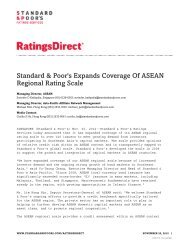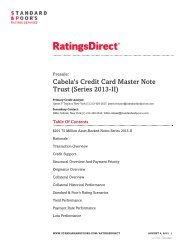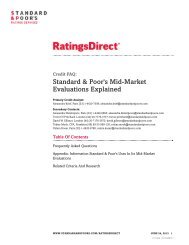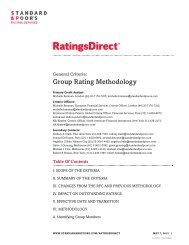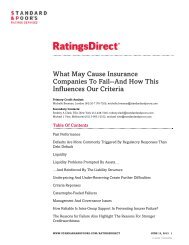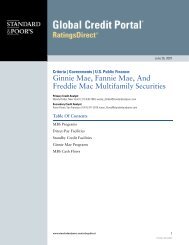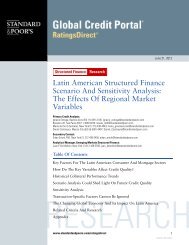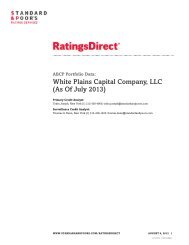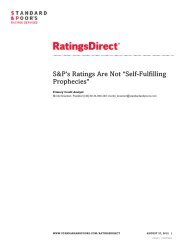Covered Bonds Face Another Tough Year - Standard & Poor's
Covered Bonds Face Another Tough Year - Standard & Poor's
Covered Bonds Face Another Tough Year - Standard & Poor's
Create successful ePaper yourself
Turn your PDF publications into a flip-book with our unique Google optimized e-Paper software.
STRUCTUREDFINANCERESEARCH<strong>Covered</strong> <strong>Bonds</strong> <strong>Face</strong> <strong>Another</strong> <strong>Tough</strong><strong>Year</strong>Primary Credit Analyst:Mark S Boyce, London (44) 20-7176-8397; Mark_Boyce@standardandpoors.comSecondary Contacts:James M Wiemken, London (44) 20-7176-7073; james_wiemken@standardandpoors.comKarlo S Fuchs, Frankfurt (49) 69-33-999-156; karlo_fuchs@standardandpoors.comRoberto Paciotti, Milan (39) 02-72111-261; roberto_paciotti@standardandpoors.comTable Of ContentsLower Funding Needs Kept Pressure On Issuance In 2012……But Tightening Spreads And Maturing <strong>Bonds</strong> Could Add To VolumesNew Jurisdictions Could Contribute To Placements, But Issuance LimitsWill Eventually Constrain VolumesNiche Assets And Pass-Through Structures May Become More PrevalentRelatively Lenient Regulatory Treatment Is A Medium-Term Positive ForThe SectorAsset Default Risk Rises, But Overcollateralization Levels Hold RelativelySteadyCounterparty Criteria Update And Lower Sovereign Ratings CauseDowngrades, And More Outlooks Are NegativeRelated Criteria And ResearchWWW.STANDARDANDPOORS.COM/RATINGSDIRECT JANUARY 24, 2013 11066010 | 301691467
<strong>Covered</strong> <strong>Bonds</strong> <strong>Face</strong> <strong>Another</strong> <strong>Tough</strong> <strong>Year</strong>Global covered bond issuance fell sharply in 2012, as many European issuers met much of their short-term fundingneeds through cheaper central bank liquidity available near the beginning of the year. However, <strong>Standard</strong> & <strong>Poor's</strong>Ratings Services believes that lower issuance costs and a spike in maturing bonds in 2013 could keep volumes thisyear broadly in line with the 2012 figure.Most issuers continue to maintain overcollateralization (OC) levels that are sufficient to maintain the ratings on theirprograms. Nevertheless, by January 2013, we had lowered our ratings on more than 25% of covered bond programsoutstanding a year earlier, and our ratings on a significant number of covered bond programs currently have a negativeoutlook or are on CreditWatch negative—in many cases because of similar outlooks on the sponsor bank or sovereignrating. Further bank and sovereign downgrades in 2013 would therefore likely have a knock-on effect on covered bondratings.Overview• Europe's investor-placed benchmark covered bond issuance reached €130 billion in 2012—down almost 40%year-on-year—as several banks took advantage of the ECB's three-year LTROs to fund future liabilities. Manyissuers may have reduced their funding needs for 2013 as a result, likely constraining covered bond volumes.• However, about €160 billion of covered bonds that <strong>Standard</strong> & <strong>Poor's</strong> rates is scheduled to mature this year,50% more than in 2012. This, along with sharply tightening covered bond issuance spreads, may tempt somesponsors back to the market in 2013, possibly sustaining volumes at about the 2012 level, in our opinion.• Tighter spreads may also see some more investor-placed issuance from sponsors in southern Europe andIreland, and we expect significant volumes from relatively new jurisdictions such as Australia and Belgium.• Pressure on European mortgage borrowers has recently pushed up credit risk in some mortgage covered bondprograms, but target and actual OC levels have remained relatively steady over the past few years.• Still, declining bank and sovereign creditworthiness led to some downgrades in 2012, and our ratings on one inthree programs currently have a negative outlook. This suggests that some program ratings may come underpressure this year as well.In this report, "benchmark" refers to issuance with a notional of €500 million or more.Lower Funding Needs Kept Pressure On Issuance In 2012…European benchmark covered bond issuance (including issuance retained by issuers) totaled about €205 billion in2012, according to J.P. Morgan data—a 20% drop from 2011, and reversing the trend of rising volumes since 2009.Investor-placed volumes fell in most European countries, and reached only €130 billion last year—40% less than in2011 (see charts 1 and 2). As in 2011, Spanish and Italian issuers accounted for almost all retained volumes, whichincreased about 60% year-on-year.WWW.STANDARDANDPOORS.COM/RATINGSDIRECT JANUARY 24, 2013 21066010 | 301691467
<strong>Covered</strong> <strong>Bonds</strong> <strong>Face</strong> <strong>Another</strong> <strong>Tough</strong> <strong>Year</strong>Chart 1WWW.STANDARDANDPOORS.COM/RATINGSDIRECT JANUARY 24, 2013 31066010 | 301691467
<strong>Covered</strong> <strong>Bonds</strong> <strong>Face</strong> <strong>Another</strong> <strong>Tough</strong> <strong>Year</strong>Chart 2Lower investor-placed issuance is largely down to European banks' participation in the European Central Bank's (ECB)three-year long-term refinancing operations (LTROs) in late 2011 and early 2012, in our view. Lenders borrowed morethan €1 trillion under the programs, pushing up retained covered bond issuance for potential use as LTRO collateral,and allowing several banks to meet much of their funding needs in the short term. Lower borrowing requirements,especially in the face of weak underlying mortgage lending growth throughout Europe, may also constrain volumes in2013.…But Tightening Spreads And Maturing <strong>Bonds</strong> Could Add To VolumesNevertheless, several factors suggest to us that investor-placed covered bond issuance this year could remain roughlythe same as the 2012 figure, absent further large-scale intervention in the wholesale funding markets by governmentsor central banks. About €160 billion of covered bonds that we rate are scheduled to be repaid in 2013—50% more thanin 2012 (see chart 3). Some programs are winding down, meaning that new covered bond placements are likely to bebelow aggregate redemptions, in our view. Nevertheless, we anticipate that the uptick in maturing bonds this year willsupport issuance volumes.WWW.STANDARDANDPOORS.COM/RATINGSDIRECT JANUARY 24, 2013 41066010 | 301691467
<strong>Covered</strong> <strong>Bonds</strong> <strong>Face</strong> <strong>Another</strong> <strong>Tough</strong> <strong>Year</strong>European covered bond spreads also continue to benefit from rising investor confidence, following the ECB's LTROsand subsequent commitment to support eurozone (European Economic and Monetary Union) sovereigns. As a result,covered bond issuance remains a competitive funding source for several issuers, even though unsecured bank fundingcosts have reduced more sharply over the past year (see chart 4). In some cases—for example, in the U.K.—coveredbond spreads have tightened more than those for senior residential mortgage-backed securities (RMBS). We expectthat attractive pricing will prompt opportunistic placements this year, despite lower funding needs.Chart 3WWW.STANDARDANDPOORS.COM/RATINGSDIRECT JANUARY 24, 2013 51066010 | 301691467
<strong>Covered</strong> <strong>Bonds</strong> <strong>Face</strong> <strong>Another</strong> <strong>Tough</strong> <strong>Year</strong>Chart 4Tighter spreads also led to investor-placements from non-core countries in 2012, which looks set to continue this year.Secondary spreads for 'AA'- and 'A'-rated covered bonds reduced by about 300 basis points (bps) during 2012,compared with about 60 bps for 'AAA'-rated issuance (see chart 5). In this context, Unicredit managed to pricenon-'AAA' benchmarks in August 2012 and January 2013 at 80 bps to 100 bps inside Italian treasuries, and inNovember, Bank of Ireland and Allied Irish Banks placed the first covered bonds from the country since 2009. CaixaGeral de Depósitos recently followed suit, launching the first Portuguese benchmark in more than two years, andJanuary 2013 has seen a flurry of issuance from Spain. Some southern European issuers could also opt for earlyrepayment of LTRO borrowings in 2013, potentially leading to further primary market activity.WWW.STANDARDANDPOORS.COM/RATINGSDIRECT JANUARY 24, 2013 61066010 | 301691467
<strong>Covered</strong> <strong>Bonds</strong> <strong>Face</strong> <strong>Another</strong> <strong>Tough</strong> <strong>Year</strong>Chart 5New Jurisdictions Could Contribute To Placements, But Issuance Limits WillEventually Constrain VolumesWe expect banks in countries that are relatively new to covered bonds to contribute significantly to 2013 issuance.Following the introduction of a covered bond law in 2011, Australian issuers placed more than €25 billion inbenchmark paper with investors in 2012—15% of the global total—and we estimate that major Australian issuerscurrently have capacity to sell a further €70 billion. In addition, Belfius Bank and KBC Bank promptly launchedcovered bond programs after the introduction of Belgian legislation in the second half of 2012, and according to a Bankof America Merrill Lynch estimate, the five largest Belgian banks could currently issue €65 billion to €80 billion more.Issuance from New Zealand (only about €3 billion in 2012) will likely remain modest this year too, in our view.Other emerging (or reemerging) jurisdictions could also add a small amount to total issuance for 2013. In Asia-Pacific,a draft Korean covered bond bill may become law, and Singapore banks could issue under proposed covered bondrules. Last year, Panama saw the first ever Latin American covered bond rated by <strong>Standard</strong> & <strong>Poor's</strong>, and weanticipate that Mexico and Chile might see some issuance in 2013.WWW.STANDARDANDPOORS.COM/RATINGSDIRECT JANUARY 24, 2013 71066010 | 301691467
<strong>Covered</strong> <strong>Bonds</strong> <strong>Face</strong> <strong>Another</strong> <strong>Tough</strong> <strong>Year</strong>The U.S. remains a question mark. On the positive side, U.S. investor interest in covered bonds appears strong, buoyedby demand for higher-yielding assets: U.S. dollar-denominated paper accounted for almost 20% of global benchmarkplacements in 2012—up from about 12% in 2011. Among the issuances was the first transaction fully registered withthe Securities and Exchange Commission, a format which could potentially attract a broader range of investors to theasset class if other issuers follow suit. Furthermore, the recent end of the presidential election cycle could provide anopportunity for legislators to refocus on passage of the draft covered bond law. That said, even with legislation inplace, covered bond placements might still not make economic sense for many potential issuers in the short term,given the outsized role of government-sponsored enterprises in providing mortgage finance.Although emerging covered bond jurisdictions are starting to add meaningfully to global issuance, we note thatlegally-mandated limits will cap placements in the medium term. Concerns about asset encumbrance—the risk thatdepositors in a failed institution will be left with a claim on a relatively small proportion of its assets—have ledregulators to impose a ceiling on issuance as a proportion of bank assets in Canada, Australia, New Zealand, andBelgium, and draft rules in Korea and Singapore do the same. In 2012, Commerzbank estimated that Australian bankscould run up against the limit as soon as 2014, at the current pace.Niche Assets And Pass-Through Structures May Become More PrevalentIssuers' wish to fund esoteric assets led to some nontraditional issuance in 2012. NORD/LB launched the world's firstaircraft Pfandbrief, and the Spanish government passed a law creating a new type of covered bonds (cédulas deinternacionalización) that can be backed by export credits. Commerzbank also became the first major European issuerto set up a program backed by small and midsize enterprises (SMEs).We expect aircraft Pfandbrief to remain a niche product, but SME-backed issuance may have more potential, in ourview, given the importance of small business lending to European economies. Nonetheless, we note that severalfactors could complicate SME covered bond analysis for investors—including the nonstandard nature of many SMEloans and the lack of industry-wide collateral quality criteria. For the time being, SME covered bonds also remainineligible for favorable regulatory treatment (for example, in bank capital rules), which may limit take-up.We have observed changing payment structures varying as well. Historically, legislation-enabled covered bonds keptto fixed payment terms and relied on the strength of the legislative framework to support payment immediatelyfollowing a bank's insolvency. Structured covered bonds in jurisdictions with less specific legislation often utilizedextendable maturity features to provide additional time—typically one year—to allow the enforcement mechanism(the liquidation of cover pool assets to meet maturing covered bond liabilities) to function. Lately, however, issuers incountries with covered bond legislation have also used extendable maturities, and some covered bonds have sold withconversion features that extend beyond one year—converting to pass-through obligations if the issuer defaults. Forexample, Commerzbank's SME covered bond program, which is not legislation-enabled, will reportedly incorporate apass-through mechanism. Such features add a degree of flexibility to the terms of the covered bond by reducingasset-liability mismatch (ALMM) risk—the risk that, if the original issuer defaults and is no longer able to makepayments on the bonds, the repayment profiles of the cover pool assets and the liabilities differ, resulting in potentialshortfalls to bondholders. In such programs, target OC levels may fall as a result. Even so, these same features mayWWW.STANDARDANDPOORS.COM/RATINGSDIRECT JANUARY 24, 2013 81066010 | 301691467
<strong>Covered</strong> <strong>Bonds</strong> <strong>Face</strong> <strong>Another</strong> <strong>Tough</strong> <strong>Year</strong>also make payment timings less certain, and could therefore be less attractive to some traditional covered bondinvestors.Relatively Lenient Regulatory Treatment Is A Medium-Term Positive For TheSectorLooking longer term, comparatively favorable treatment of covered bonds under current and upcoming regulationscould help sustain volumes, in our view. Under the January 2013 draft Basel III liquidity rules for banks, RMBS,although included as liquid assets for the first time, are subject to a higher rating requirement and a larger haircut (orpercentage reduction in value) than covered bonds. Securitizations would also typically incur a higher risk weightingthan similarly-rated covered bonds under proposed bank capital rules, currently under consultation. Insurers andpension funds must hold up to 10 times more capital against 'AAA'-rated securitization assets than for similarly-ratedcovered bonds, under the most recent formulation of Solvency II and IORP II regulations (see "Solvency II Could PushEuropean Insurers Away From Securitizations," published on Dec. 10, 2012). Finally, securitizations typically incur alarger haircut than covered bonds when posted as collateral in European Central Bank repurchase operations. Weanticipate that these rules may be leading some issuers and investors to favor covered bond over securitizationissuance, all else being equal.We note that the current proposal for a European bank recovery and resolution framework, scheduled to becomeeffective in 2013, with transposition into national law in 2015, is another modest positive for the European coveredbond market. The framework exempts covered bonds from the write-downs related to the resolution of failedinstitutions, quelling speculation that covered bond investors might be forced to suffer losses.We also view the introduction of the European <strong>Covered</strong> Bond Council's (ECBC) labeling initiative in late 2012 as amedium-term positive for issuance from certain countries. Issuers with legislation-enabled programs opting toperiodically disclose certain cover pool information are eligible for the label, and as of January 2013, more than 60issuers from 14 countries have signed up. As covered bonds continue to expand into more jurisdictions, we believethat investors could value the additional transparency associated with labeled issues.Asset Default Risk Rises, But Overcollateralization Levels Hold RelativelySteadyIn 2011 and 2012, cover pool collateral quality deteriorated slightly in some countries, in the face of Europe'seconomic slowdown. In Q3 2012, asset default risks (which include all credit and cash flow risks except the marketvalue risk arising from ALMMs) among mortgage covered bond programs that <strong>Standard</strong> & <strong>Poor's</strong> rates required OC ofabout 15%—up from about 10% in Q2 2011—in part due to increases in Spain.Nevertheless, for the most part, banks continue to maintain OC levels that are sufficient to maintain achievable ratings.The average actual credit enhancement level has remained fairly steady over the past several years at more than 50%,while target credit enhancement necessary to maintain ratings has remained close to 30% (although these figures varyconsiderably by country). We have also witnessed banks raising levels when necessary to support ratings. ForWWW.STANDARDANDPOORS.COM/RATINGSDIRECT JANUARY 24, 2013 91066010 | 301691467
<strong>Covered</strong> <strong>Bonds</strong> <strong>Face</strong> <strong>Another</strong> <strong>Tough</strong> <strong>Year</strong>example, most programs increased OC levels in response to ALMM risks identified with the release of our criteria onthis subject in 2009. On average, about two-thirds of OC levels relate to the coverage of ALMM risk.Program issuers' active management of OC levels is important even with stable and strong collateral. Regularlymaturing collateral and fluctuating covered bonds issuance outstanding requires covered bond issuers to monitorcollateral levels to meet legislative or contractual requirements, public commitments, or internal targets necessary tomaintain credit ratings or other benchmarks. Although there are some restrictions on the additional collateral thatissuers can use to replenish cover pools, these features result in a more dynamic structure relative to most othersecuritizations with substitution features.However, not all issuers have maintained target credit enhancement levels—including some that have come understress and have had to endure bailouts or restructurings. For banks that see their programs as an important part oftheir continuing activities post-restructuring, we have seen OC levels maintained or even increased to shore up marketsupport, and we believe this will continue. For banks that have chosen to wind down covered bond programs, therecord is more mixed. Some have maintained but not increased levels, while others have purposefully withdrawn OC,which has resulted in lower ratings.Counterparty Criteria Update And Lower Sovereign Ratings CauseDowngrades, And More Outlooks Are NegativeFalling sovereign creditworthiness has had a substantial negative effect on covered bond program ratings. Of the 95programs that we rated in January 2012, 25 had lower ratings in January 2013 (or were downgraded before wewithdrew the rating), with sovereign downgrades on Spain, Italy, and Portugal fully or partly responsible for 11 of thedownward rating transitions (see chart 6). (Note that several downgrades—driven by different factors—may havecaused a downward rating transition between January 2012 and January 2013, so the figures in the chart amount tomore than 25.) A recent change to our methodology for assessing counterparty risk also played a role in eightdownward rating transitions over the period (see "<strong>Covered</strong> <strong>Bonds</strong> Counterparty And Supporting ObligationsMethodology And Assumptions," published on May 31, 2012).Although sponsor downgrades led to only four downward rating transitions, we note that negative outlooks on severalbanks (and some sovereigns) mean that the outlook for covered bond ratings has deteriorated. In January 2013, one inthree covered bond program ratings had a negative outlook or were on CreditWatch negative—nearly double the Q22011 figure (see chart 7). This suggests that covered bond ratings could remain under pressure in the coming quarters.In fact, a growing proportion of covered bonds are no longer rated 'AAA'. In January 2013, less than two-thirds ofprograms achieved the rating, compared with about 85% in Q2 2011 (see chart 8). We don't anticipate this changinganytime soon.WWW.STANDARDANDPOORS.COM/RATINGSDIRECT JANUARY 24, 2013 101066010 | 301691467
<strong>Covered</strong> <strong>Bonds</strong> <strong>Face</strong> <strong>Another</strong> <strong>Tough</strong> <strong>Year</strong>Chart 6WWW.STANDARDANDPOORS.COM/RATINGSDIRECT JANUARY 24, 2013 111066010 | 301691467
<strong>Covered</strong> <strong>Bonds</strong> <strong>Face</strong> <strong>Another</strong> <strong>Tough</strong> <strong>Year</strong>Chart 7WWW.STANDARDANDPOORS.COM/RATINGSDIRECT JANUARY 24, 2013 121066010 | 301691467
<strong>Covered</strong> <strong>Bonds</strong> <strong>Face</strong> <strong>Another</strong> <strong>Tough</strong> <strong>Year</strong>Chart 8Related Criteria And Research• European Securitization: More Of The Same In 2013?, Dec. 18, 2012• Solvency II Could Push European Insurers Away From Securitizations, Dec. 10, 2012• <strong>Standard</strong> & <strong>Poor's</strong> Assumptions For Assessing Belgian <strong>Covered</strong> <strong>Bonds</strong>, Nov. 27, 2012• Key Credit Considerations For Korean <strong>Covered</strong> <strong>Bonds</strong> Under Possible Legislative Framework, Sept. 26, 2012• Where Funding Is Concerned, <strong>Covered</strong> <strong>Bonds</strong> Are Mildly Supportive For Some Asia-Pacific Banks, Sept. 10, 2012• A Comparative Analysis Of Australian <strong>Covered</strong> Bond Programs, Aug. 30, 2012• <strong>Covered</strong> Bond Ratings Framework: Methodology And Assumptions, June 26, 2012• <strong>Covered</strong> <strong>Bonds</strong> Counterparty And Supporting Obligations Methodology And Assumptions, May 31, 2012• Most <strong>Covered</strong> Bond Ratings Hold Steady As Issuer Ratings Fall, April 26, 2012• Assessing Asset-Liability Mismatch Risk In <strong>Covered</strong> <strong>Bonds</strong>: Revised Methodology And Assumptions For TargetAsset Spreads, April 24, 2012• S&P Comments On Emerging Frameworks For <strong>Covered</strong> <strong>Bonds</strong> In Asia Pacific, April 19, 2012• Q&A: Are <strong>Covered</strong> <strong>Bonds</strong> All They're Cracked Up To Be?, Feb. 16, 2012• Revised Methodology And Assumptions For Assessing Asset-Liability Mismatch Risk In <strong>Covered</strong> <strong>Bonds</strong>, Dec. 16,2009WWW.STANDARDANDPOORS.COM/RATINGSDIRECT JANUARY 24, 2013 131066010 | 301691467
<strong>Covered</strong> <strong>Bonds</strong> <strong>Face</strong> <strong>Another</strong> <strong>Tough</strong> <strong>Year</strong>• Global <strong>Covered</strong> Bond Characteristics And Rating Summary, published quarterlyAdditional Contact:Structured Finance Europe; StructuredFinanceEurope@standardandpoors.comWWW.STANDARDANDPOORS.COM/RATINGSDIRECT JANUARY 24, 2013 141066010 | 301691467
Copyright © 2013 by <strong>Standard</strong> & <strong>Poor's</strong> Financial Services LLC. All rights reserved.No content (including ratings, credit-related analyses and data, model, software or other application or output therefrom) or any part thereof(Content) may be modified, reverse engineered, reproduced or distributed in any form by any means, or stored in a database or retrieval system,without the prior written permission of <strong>Standard</strong> & <strong>Poor's</strong> Financial Services LLC or its affiliates (collectively, S&P). The Content shall not be usedfor any unlawful or unauthorized purposes. S&P and any third-party providers, as well as their directors, officers, shareholders, employees or agents(collectively S&P Parties) do not guarantee the accuracy, completeness, timeliness or availability of the Content. S&P Parties are not responsible forany errors or omissions (negligent or otherwise), regardless of the cause, for the results obtained from the use of the Content, or for the security ormaintenance of any data input by the user. The Content is provided on an "as is" basis. S&P PARTIES DISCLAIM ANY AND ALL EXPRESS ORIMPLIED WARRANTIES, INCLUDING, BUT NOT LIMITED TO, ANY WARRANTIES OF MERCHANTABILITY OR FITNESS FOR APARTICULAR PURPOSE OR USE, FREEDOM FROM BUGS, SOFTWARE ERRORS OR DEFECTS, THAT THE CONTENT'S FUNCTIONINGWILL BE UNINTERRUPTED, OR THAT THE CONTENT WILL OPERATE WITH ANY SOFTWARE OR HARDWARE CONFIGURATION. In noevent shall S&P Parties be liable to any party for any direct, indirect, incidental, exemplary, compensatory, punitive, special or consequentialdamages, costs, expenses, legal fees, or losses (including, without limitation, lost income or lost profits and opportunity costs or losses caused bynegligence) in connection with any use of the Content even if advised of the possibility of such damages.Credit-related and other analyses, including ratings, and statements in the Content are statements of opinion as of the date they are expressed andnot statements of fact. S&P's opinions, analyses, and rating acknowledgment decisions (described below) are not recommendations to purchase,hold, or sell any securities or to make any investment decisions, and do not address the suitability of any security. S&P assumes no obligation toupdate the Content following publication in any form or format. The Content should not be relied on and is not a substitute for the skill, judgmentand experience of the user, its management, employees, advisors and/or clients when making investment and other business decisions. S&P doesnot act as a fiduciary or an investment advisor except where registered as such. While S&P has obtained information from sources it believes to bereliable, S&P does not perform an audit and undertakes no duty of due diligence or independent verification of any information it receives.To the extent that regulatory authorities allow a rating agency to acknowledge in one jurisdiction a rating issued in another jurisdiction for certainregulatory purposes, S&P reserves the right to assign, withdraw, or suspend such acknowledgement at any time and in its sole discretion. S&PParties disclaim any duty whatsoever arising out of the assignment, withdrawal, or suspension of an acknowledgment as well as any liability for anydamage alleged to have been suffered on account thereof.S&P keeps certain activities of its business units separate from each other in order to preserve the independence and objectivity of their respectiveactivities. As a result, certain business units of S&P may have information that is not available to other S&P business units. S&P has establishedpolicies and procedures to maintain the confidentiality of certain nonpublic information received in connection with each analytical process.S&P may receive compensation for its ratings and certain analyses, normally from issuers or underwriters of securities or from obligors. S&Preserves the right to disseminate its opinions and analyses. S&P's public ratings and analyses are made available on its Web sites,www.standardandpoors.com (free of charge), and www.ratingsdirect.com and www.globalcreditportal.com (subscription), and may be distributedthrough other means, including via S&P publications and third-party redistributors. Additional information about our ratings fees is available atwww.standardandpoors.com/usratingsfees.WWW.STANDARDANDPOORS.COM/RATINGSDIRECT JANUARY 24, 2013 151066010 | 301691467




